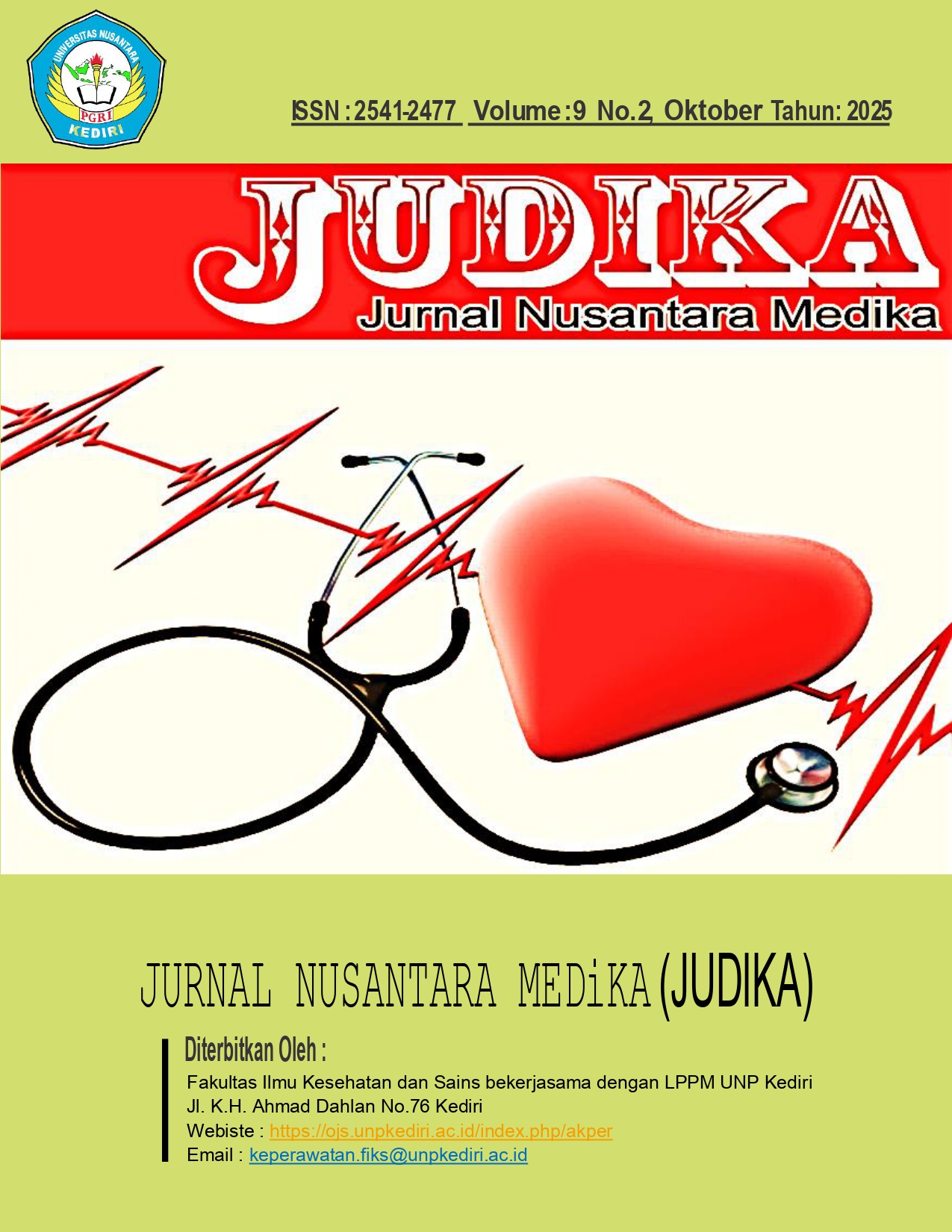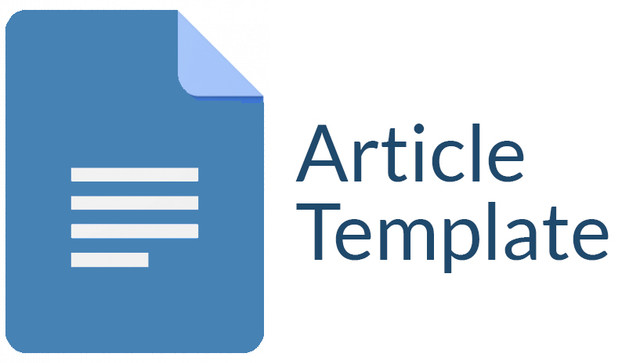Gambaran Faktor Terjadinya Kenaikan Berat Badan Berlebih Pada Ibu Hamil Tm III Di Poliklinik Kebidanan RSU Islam Cawas
DOI:
https://doi.org/10.29407/judika.v9i2.27158Keywords:
Berat Badan Berlebih, Genetik, Sedentary life, pola makan, aktifitas fisikAbstract
Latar Belakang: Berat badan berlebih yang biasa dianggap overweight atau kegemukan merupakan keadaan serba berlebih dengan resiko besar terhadap kesehatan seseorang. Berat badan berlebih merupakan kondisi medis di mana terjadi penumpukan lemak yang berlebihan dalam tubuh. Beberapa penyebab terjadinya kondisi tersebut yang akan diangkat dalam penelitian ini nanti yaitu genetik, sedentary life, pola makan, dan aktifitas fisik. Tujuan: Untuk mengetahui gambaran faktor terjadinya berat badan berlebih pada ibu hamil di poliklinik kebidanan RSU Islam Cawas. Metode: Penelitian ini menggunakan pendekatan penelitian observasi deskriptif. Sampel yang digunakan yaitu 35 orang. Teknik pengumpulan data yaitu dengan menggunakan kuesioner. Dengan cara pengambilan dari data primer dan sekunder. Yang kemudian diolah melalui editing, coding, skoring, entry data dan cleaning. Hasil: Karakteristik subjek berdasarkan IMT 14 orang berada pada kategori normal (40%), tetapi secara keseluruhan 100% masuk dalam kategori keniakan berat badan berlebih. Faktor genetik 29 orang (82,86%) memiliki genetik BB berlebih, faktor sedentary life 27 orang (77,145) pada kategori tinggi, faktor pola makan 23 orang (65,71%) kategori baik, dan faktor aktifitas fisik 35 orang (100%) kategori sedang. Kesimpulan: Berdasarkan hasil penelitian dapat ditarik kesimpulan bahwa faktor terjadinya berat badan berlebih yang paling dominan yaitu pada genetik.
Downloads
References
Aljassim, H., & Jradi, H. (2021). Childhood overweight and obesity among the Saudi population: a case-control study among school children. Journal of Health, Population and Nutrition, 40(1), 1–9. https://doi.org/10.1186/s41043-021-00242-1
Amoh, I., & Appiah-Brempong, E. (2017). Prevalence and risk factors of obesity among senior high school students in the Adansi North district of Ghana. International Journal Of Community Medicine And Public Health, 4(10), 3762. https://doi.org/10.18203/2394-6040.ijcmph20174247
Badan Penelitian dan Pengembangan Kesehatan RI. (2018). Laporan Riskesdas 2018 Nasional. In Lembaga Penerbit Balitbangkes (p. 156).
Banjarnahor, R. O., Banurea, F. F., Panjaitan, J. O., Pasaribu, R. S. P., & Hafni, I. (2022). Faktor-faktor risiko penyebab kelebihan berat badan dan obesitas pada anak dan remaja: Studi literatur. Tropical Public Health Journal, 2(1), 35–45. https://doi.org/10.32734/trophico.v2i1.8657
Catalano, P. M. (2019). The impact of gestational diabetes and maternal obesity on the mother and her offspring. J Dev Orig Health Dis, 46(2), 248–256. https://doi.org/10.1017/S2040174410000115.The
Choudhary, K., Mathur, P., Garg, M., & Gupta, P. P. (2017). Prevalence of overweight and obesity amongst adolescents and identification of risk factors. International Journal of Contemporary Pediatrics, 4(4), 1153. https://doi.org/10.18203/2349-3291.ijcp20171729
Hanani, R., Badrah, S., & Noviasty, R. (2021). Pola Makan, Aktivitas Fisik dan Genetik Mempengaruhi Kejadian Obesitas pada Remaja. Jurnal Kesehatan Metro Sai Wawai, 14(2), 120–129. https://doi.org/http://dx.doi.org/10.26630/jkm.v14i2.2665
Kemenkes RI. (2019). Profil Kesehatan Indonesia Tahun 2019 (B. Hardhana, F. Sibuea, & W. Widiantini (eds.); 1st Ed). Kementerian Kesehatan Republik Indonesia.
Kuswandi, P. C., & Rahayu, T. (2022). Analisis Korelasi Indeks Massa Tubuh (IMT) dalam Keluarga Remaja Putri yang Mengalami Obesitas di Yogyakarta. Jurnal Sains Dasar, 11(1), 1–6. https://doi.org/10.21831/jsd.v11i1.44921
Lynch, A. M., Eckel, R. H., Murphy, J. R., Gibbs, R. S., West, N. A., Giclas, P. C., Salmon, J. E., & Holers, V. M. (2012). Prepregnancy obesity and complement system activation in early pregnancy and the subsequent development of preeclampsia. American Journal of Obstetrics & Gynecology, 206(5), 428.e1-428.e8. https://doi.org/10.1016/j.ajog.2012.02.035
Mihrshahi, S., Drayton, B. A., Bauman, A. E., & Hardy, L. L. (2017). Associations between childhood overweight, obesity, abdominal obesity and obesogenic behaviors and practices in Australian homes. BMC Public Health, 18(1), 1–10. https://doi.org/10.1186/s12889-017-4595-y
Natalia, J. R., Rodiani, & Zulfadil. (2020). The Impact of Maternal Obesity on Fetal Weight. Medula, 10, 539–544.
Rachma, R. A., & Mahmudiono, T. (2023). Hubungan Faktor Genetik dan Asupan Energi dengan Kejadian Obesitas. Media Gizi Kesmas, 12(2), 1002–1006.
Sahayati, S., Rahmuniyati, M. E., Pramudita, S. A., & Hallo, F. P. (2022). Pemeriksaan Gula Darah pada Ibu Hamil Sebagai Upaya Deteksi Awal Diabetes Gestasional. Jurnal Pengabdian Kesehatan Masyarakat, 1(2), 62–68. https://doi.org/https://doi.org/10.35842/jas.v1i2.15
SALIM, A. N. (2014). FAKTOR-FAKTOR YANG BERHUBUNGAN DENGAN KEJADIAN OBESITAS PADA KARYAWATI SEKRETARIAT DAERAH KABUPATEN WONOSOBO. Universitas Muhammadiyah Semarang.
Susila, & Margono. (2014). Metodologi Penelitian Cross Sectional Kedokteran dan Kesehatan (1st Ed). BOSSSCRIPT.
Widyantari, N. M. A., Nuryanto, I. K., & Dewi, K. A. P. (2018). Hubungan Aktivitas Fisik, Pola Makan, Dan Pendapatan Keluarga Dengan Kejadian Obesitas Pada Anak Sekolah Dasar. Jurnal Riset Kesehatan Nasional, 2(2), 214–222. https://doi.org/10.37294/jrkn.v2i2.121
Yusnanda, F., Rochadi, R. K., & Maas, L. T. (2019). Pengaruh Riwayat Keturunan terhadap Kejadian Diabetes Mellitus pada Pra Lansia di BLUD RSUD Meuraxa Kota Banda Aceh Tahun 2017. Journal of Healthcare Technology and Medicine, 4(1), 18. https://doi.org/10.33143/jhtm.v4i1.163
Downloads
Published
Issue
Section
License
Copyright (c) 2025 aini atikah, Sugita, Dwo Retna Prihati

This work is licensed under a Creative Commons Attribution-ShareAlike 4.0 International License.
Authors who publish with this journal agree to the following terms:
- Copyright on any article is retained by the author(s).
- The author grants the journal, right of first publication with the work simultaneously licensed under a Creative Commons Attribution License that allows others to share the work with an acknowledgment of the work’s authorship and initial publication in this journal.
- Authors are able to enter into separate, additional contractual arrangements for the non-exclusive distribution of the journal’s published version of the work (e.g., post it to an institutional repository or publish it in a book), with an acknowledgment of its initial publication in this journal.
- Authors are permitted and encouraged to post their work online (e.g., in institutional repositories or on their website) prior to and during the submission process, as it can lead to productive exchanges, as well as earlier and greater citation of published work.
- The article and any associated published material is distributed under the Creative Commons Attribution-ShareAlike 4.0 International License













